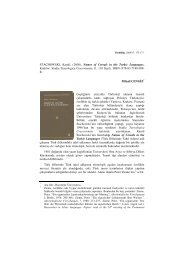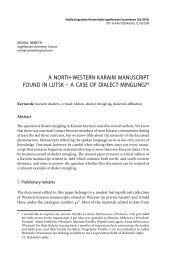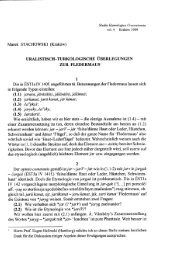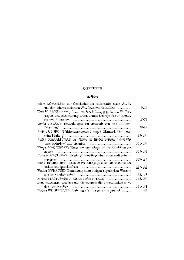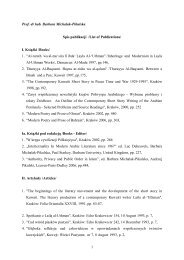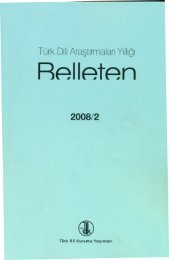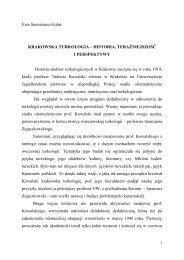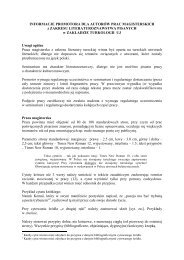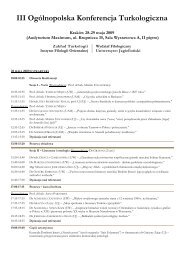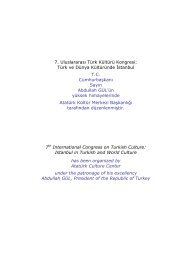Corn || kokoroz 23kukurūsa Yak.: Slepcov 1975 (from 1935)kukurusь Čuv.: Nikolьskij 1909kukuruz Bosn.Tksh.: R II 897m || Bšk.: Dmitrieva 1972: 213 || Tat.: RTatS-D, RTatS-G|| Tksh.: Eren 1999kukuruza Bšk.: RBškS, Dmitrieva 1972 || Čuv.: Dmitrieva 1972: 213, RČuvS-A,RČuvS-D, RČuvS-E || Khak.: RChakS, Dmitrieva 1972: 213 || Oyr.: RAltS ||Tat.: Dmi trieva 1972: 213 || Tuv.: Dmitrieva 1972: 213 || Yak.: RJakS, Dmitrieva1972: 213, Slepcov 1975 (s<strong>in</strong>ce 1935)languages:Bosn.Tksh.: kukuruz || Bšk.: kukuruz, kukuruza || Čuv.: kukkurus, kukurusь, kukuruza|| KarC.: kokoroz || Khak.: kukuruza || Ott.: kokoroz || Oyr.: kukuruza || Tat.: kukurus,kukuruz, kukuruza || Tksh.: kokoroz, kukuruz || Tuv.: kukuruza || Yak.: kukurūsa, kukuruzaetymology:1930: Nikolić 9 : Tkc. [? ɔ: Tksh.] koku (or mum for <strong>the</strong> form mumuruz) ‘st<strong>in</strong>k’ + uruz‘rice’ > ‘rice <strong>of</strong> poor species’This proposition is thoroughly false for <strong>the</strong> follow<strong>in</strong>g reasons: 1. <strong>the</strong>re is no such word<strong>in</strong> <strong>the</strong> Tkc. languages as mum ‘st<strong>in</strong>k’; 2. <strong>the</strong>re is no such word <strong>in</strong> <strong>the</strong> Tkc. languagesas uruz ‘rice’; 3. a compound <strong>of</strong> two nouns <strong>in</strong> Nom. which would have this k<strong>in</strong>d <strong>of</strong>a mean<strong>in</strong>g is impossible <strong>in</strong> <strong>the</strong> Tkc. languages; 4. to <strong>the</strong> best <strong>of</strong> our knowledge, <strong>the</strong>Tkc. peoples never considered corn to be a worse k<strong>in</strong>d <strong>of</strong> cereal (and nei<strong>the</strong>r did<strong>the</strong> Slavic peoples, cf. e.g. Bulg. carevica ‘corn’), <strong>in</strong> fact, <strong>the</strong> exact opposite was true;5. it is very hard to f<strong>in</strong>d a major similarity between corn and rice, and we know <strong>of</strong>no parallel for unify<strong>in</strong>g <strong>the</strong>se two mean<strong>in</strong>g <strong>in</strong> <strong>the</strong> Tkc. languages.1972: Dmitrieva: Tat. kukurus, Bšk. kukuruz; Bšk., Khak., Čuv., Yak., Oyr., Tat., Tuv.kukuruza < Russ.1999: Eren: Tkc. kokoroz from <strong>the</strong> Balkan languages; cf. Bulg. kukuruz, Serb. kukùruz,Rom. cucurúz; ultimate source unclearcommentary:We believe that this word was borrowed to <strong>the</strong> Tkc. languages from Slav., as Dmi trieva 1972and Eren 1999 proposed it. In particular, <strong>the</strong> fact that <strong>the</strong> word has a very rich family <strong>in</strong> <strong>the</strong>Slav. languages and absolutely no relatives <strong>in</strong> <strong>the</strong> Tkc., speaks <strong>in</strong> favour <strong>of</strong> this proposition.The sound<strong>in</strong>g does not allow for a precise determ<strong>in</strong>ation <strong>of</strong> <strong>the</strong> Slav. source. We can onlymake a guess based on historical and cultural-historical premises. In <strong>the</strong> case <strong>of</strong> Asian Tkc.languages it was most probably Russ.; <strong>in</strong> <strong>the</strong> case <strong>of</strong> Bosn.Tksh. we may suspect a borrow<strong>in</strong>gfrom one <strong>of</strong> <strong>the</strong> Slav. languages <strong>of</strong> <strong>the</strong> Balkans or, less likely, from Tksh. (Ott.); and f<strong>in</strong>ally <strong>in</strong><strong>the</strong> case <strong>of</strong> Tksh. (Ott.) – history seems to support <strong>the</strong> idea <strong>of</strong> a borrow<strong>in</strong>g from <strong>the</strong> Balkans(as proposed by Eren 1999) ra<strong>the</strong>r than from Russ. (as Dmitrieva 1972 wants it).All this might seem somewhat strange given <strong>the</strong> fact that Europe (except for Spa<strong>in</strong>and Portugal 10 ) has learned about corn from <strong>the</strong> Ottomans (see above). However, <strong>the</strong>9 Nikolić, Agronomski glasnik 1930 and 1931; quoted after Skok 1971–74 s.v. kukuruz.10 From Spa<strong>in</strong> corn spread to France among o<strong>the</strong>r regions, and from <strong>the</strong>re to Germany, but itonly ga<strong>in</strong>ed popularity later, probably under Turkish or Hungarian <strong>in</strong>fluence.
24 kokoroz || Cornl<strong>in</strong>guistic data does not allow for any o<strong>the</strong>r solution. Most probably, <strong>the</strong> whole th<strong>in</strong>gmight be expla<strong>in</strong>ed by <strong>the</strong> follow<strong>in</strong>g facts:1. <strong>in</strong> Ott. (and later <strong>in</strong> Tksh.) <strong>the</strong> forms kukuruz ~ kokoroz are dialectal; corn was morepopular among <strong>the</strong> Slavic people than it was among <strong>the</strong> Turks; <strong>in</strong> a limited area, a Slav.word could oust its Tkc. equivalent, and <strong>the</strong>n f<strong>in</strong>d its way to <strong>the</strong> literary language2. a) all <strong>the</strong> o<strong>the</strong>r Tkc. languages where this word is present, have been under a strongRuss. <strong>in</strong>fluenceb) it is possible, that <strong>the</strong>se Tkc. nations only learned about corn from RussiansThe differences <strong>in</strong> auslaut among <strong>the</strong> Tkc. forms (-uz vs -uza) should probably be expla<strong>in</strong>edby variations <strong>in</strong> Russ. dialects (although Fil<strong>in</strong> 1965– only attests kukuróz), orby a borrow<strong>in</strong>g from Tksh. (Ott.) ra<strong>the</strong>r than from Russ.The only th<strong>in</strong>g that might still be regarded as be<strong>in</strong>g problematic is that our wordhas no established etymology <strong>in</strong> <strong>the</strong> Slav. languages. An overview <strong>of</strong> previous solutions(chronologically) and our proposition is presented below.Blr.: kukurúza || Bulg.: kukurùz || Cz.: kukuřice, kukuruc (19 th c.; Jungmann 1835–39 11 ) ||Pol.: kukurydza (20 th c.), kukurudza, kokoryca (19 th c.), kukuryza, kukuruca, kukuryca, kukurudz(18 th c.) (SEJP) || SC: kukùruz, kukùruza, kùkurica, kukuriza, kokuruz (Skok 1971–74)|| Slvk.: kukurica, kukuruc || Slvn.: koruza || Ukr.: kukurúdza || USorb.: kukurica1. < Tkc. kokoroz, kukuruz ‘corn’pro: Muchliński 1858 12 ; MiklTEl, Karłowicz 1894–1905 13 ; Lokotsch 1927; Weigand14 ; Holub/Lyer1967; Skok 1971–74; Witczak 2003: 124contra: MiklTElN; SEJP; Bańkowski 2000The word is <strong>in</strong>comprehensible on <strong>the</strong> Tkc. ground. Vast family <strong>in</strong> <strong>the</strong> Slav. languages.No related words <strong>in</strong> <strong>the</strong> Tkc. languages.2. native word; cf. Slav.S. kukurjav ‘1. curly; 2. splayed out’ (from ‘hairs’ protrud<strong>in</strong>gfrom corns)pro: Berneker 1908–13 15 , Brückner 1927; Holub/Kopečný 1952; SEJP; Machek 1968;Zaimov 1957 16 ; Schuster-Šewc 1978–89; ESUM; Černych 1993contra: Vasmer 1986–87See below.3. < Rom. cucuruz ‘1. cone; 2. corn’pro: ? MiklFremdSlav, BER; Marynaŭ 1978–; ? Bańkowski 2000See below.4. < kukuru used when lur<strong>in</strong>g birds with corn gra<strong>in</strong>spro: Vasmer 1986–8711 Jungmann 1835–39; quoted after Machek 1968.12 Muchliński 1958: 71; quoted after SEJP s.v. kukurydza.13 Karłowicz 1894–1905: 323; quoted after SEJP. s.v. kukurydza.14 Weigand, G.: Jahresbericht des Instituts für rumänische Sprache XVII-XVIII: 363f.; quoted after SEJP.15 Berneker 1908–13: 640–41; quoted after SEJP s.v. kukurydza.16 Zaimov 1957: 113–26: 117–19; quoted after SEJP s.v. kukurydza.



